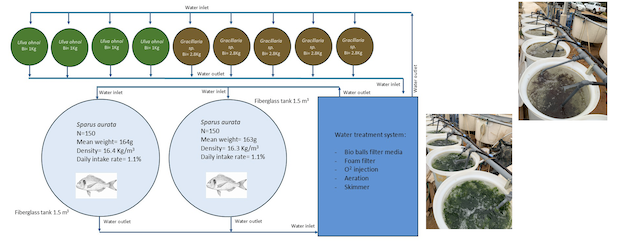Using Seaweed Produced in an iRAS (Recirculating Aquaculture System + Integrated multi-trophic aquaculture) System as Feed for Purple Sea Urchin (Paracentrotus lividus)
RAS (Recirculating Aquaculture System) is a closed-circuit system used to raise aquatic organisms, such as fish or shrimp, in a controlled environment. RAS technology is designed to minimize water usage by continuously filtering and reusing water within the system. The key components of a RAS are: tanks (where the aquatic organisms are housed), mechanical filtration: (removes solid waste), biological filtration (breaks down toxic nitrogenous into less harmful compounds using beneficial bacteria), aeration and oxygenation (ensures adequate oxygen levels in the water), disinfection (includes UV light or ozone), water pumps (water circulation) and monitoring systems (monitored critical parameters). An alternative form of RAS system involves integrating the cultivation of seaweed into the system, acting as a bioremediation agent for water quality, namely by absorbing the inorganic forms of nitrogen: nitrate (NO₃-), nitrite (NO₂-) and ammonium (NH₄⁺). These compounds are used for the synthesis of proteins, nucleic acids, and other essential organic molecules required for growth. By doing so, seaweeds help reduce the concentration of nitrogen in the water. A RAS system in which integrated cultivation of different species is applied, known as IMTA (Integrated multi-trophic aquaculture), is referred as an iRAS system.

The seaweed produced in this system could have various applications, including feeding marine organisms lower down the food chain. Sea urchins are echinoderms of great interest on the global market. Their roe, the edible part of the animal, has a high commercial value. One of the main issues in sea urchin farming is obtaining fresh seaweed biomass to feed them. Collecting seaweed from the sea is labour- and resource-intensive and is not a sustainable way of maintaining the stocks on hand, needed to feed them on an ongoing basis. Seaweed production is one of the possible solutions for feeding sea urchins, through direct application or through integration into formulated inert foods. One of the possible ways of obtaining seaweed biomass could be through production in fish and seaweeds iRAS systems. It is necessary to understand which seaweeds species are the most suitable, to assess the performance of their production in these systems, to analyze the quality of the sea urchins as a commercial product and to assess the sustainability of this system on a commercial scale.
With the aim of making sea urchin (P.lividus) production more sustainable, under the zero-waste philosophy, the project AQUAFISH 0.0 is testing an iRAS sea bream production system at EPPO's facilities, where two species of seaweed (Ulva ohnoi and Gracillaria sp.) are being tested as bioremediators in the system, and these algae are used to feed sea urchins. This trial is part of the task 1.3 (Pilot actions: Search for sustainable productive models and creation of innovative food products). The first results show that Ulva ohnoi is the seaweed species with the greatest ability to adapt to the iRAS system, being efficient at removing harmful nitrogen compounds, while at the same time showing optimum biomass growth. Its growth rate varies depending on the environmental conditions, namely light, temperature and nutrient availability, with a daily growth rate of 8.69 ± 3.25 % (biomass). This seaweed was also responsible for the better growth performance of the sea urchins, with these animals showing better growth and a better feed conversion rate. The next steps in this work will be to obtain long-term data on the general performance of the iRAS system to assess its adaptability at a commercial level, as well as to evaluate the quality of the product, i.e. the edible part of the sea urchins, in terms of nutrition and organoleptic properties.

AQUAFISH 0.0 is a project funded by ERDF through the INTERREG Atlantic Area 2021-2027 programme (project code EAPA_0062/2022).


